

Article fait par :Claude Balmefrezol
Mis en ligne le

Nike System English Version
French version
 |
The origins of the Nike System
He was a system designed to supplement and then replace gun batteries deployed around the nation’s major urban areas and vital military installations. He was a system use by the US Army and not by the USAF
Introduction
Nike ,is for the ancient Greeks the goodness of the Victory and for the Us Army the name given to a guided surface-to-air missile systeme program .
He was planning during the last months of WW2 when US.Army realized that conventional anti-aircraft artillery would not be able to provide an adequate defense against the fast, high-flying jet aircraft which were being introduced into service, particularly by the Germans.
In 1945, was built Report AAGM (Anti Aircraft Guided Missile by Bell Telephone Laboratories
The Report
This missile is a two-stage, supersonic missile which could be guided to its target by means of ground-based radar and computer systems This type of system is known as a "command" guidance system. Advantages for the missile
With a conventional by anti-aircraft artillery projectilethe projectile followed a predetermined, ballistic trajectory which could not be altered after firing. In fact with a missile , he could be continuously guided to intercept an aircraft, in spite of any evasive actions taken by its pilot
Why a Nike Missile system ?
After the WW2 begin the Cold War and the USSR began to develop a series of long-range bomber aircraft, able to reach the USA. In 1949 USSR began a atomic power with his first atomic bomb. And the outbreak of hostilities in Korea, provided a further impetus to this deployment
The problematic for the USA URSS might be able to build a long-range, nuclear-armed bomber aircraft for bombing USA. This threat provided motivation for a rapidl development and deployment of the Nike system to defend major U.S. population centers and other vital targets
Nike system was the "last ditch" line of US air defense for selected areas Nike system would have been utilized in the event that USAF long-range fighter-interceptor aircraft had failed to destroy any attacking bombers at a greater distance from their intended targets.
The birth of the Nike Family
 |
Nike Ajax: The First Nike Missile
The Nike Ajax contractor, was Western Electric’s Bell Telephone Laboratories, who produce 350 missile batteries for domestic and overseas deployment with a first successful test firing of missile occurred in 1951. This first Nike missile was named latter Nike "Ajax". The primary subcontractor,was Douglas Aircraft, who built 13,714 missiles at Santa Monica plant and at the Army Ordnance Missile Plant located at Charlotte, North Carolina.
Nike Ajax was a slender, two-stage guided missile powered by a liquid-fuelled motor utilizing a combination of inhibited red fuming nitric acid (IRFNA), unsymmetrical dimethyl hydrazine (UDMH) and JP-4 jet petroleum. The Ajax was blasted off of its launcher by means of a jettisonable solid fuel rocket booster which fired for about 3 seconds, accelerating the missile with a power of 25 time the force of gravity.
Nike Ajax was able of maximum speeds of over mach 2.5 and could reach targets at altitudes of up to 22 kms but with a range of only 40 kms he has many detractors . For them is too short to make it a truly effective air defense weapon .
But its supporters says that the missile is superior to conventional antiaircraft artillery
Nike Ajax System
 |
| Internet |
He was armed with three individual high-explosive, fragmentation-type warheads located at the front, center and rear of the missile body. He was never armed with a nuclear warhead,
In march 1954, he was deployed for the first time on an above-ground site at Fort Meade, Maryland, and on 1958,Us Army has deployed 200 Nike Ajax batteries around the nation’s cities and vital military installations. In June 1958, the conversion to the new Nike B later Hercules began. Subsequently, the Nike Ajax batteries were either modified to accept the new missile or deactivated. In November 1963, Site N-63 in Norfolk, Virginia, was the last Nike Ajax battery to be deactivated.
However, the Nike Ajax missile continued service overseas with the U.S. Army and with the military forces of America’s allies for many more years.
But soon Us Army began gradually deactivating the Nike Ajax batteries and replacing them with the longer-range nuclear-capable Nike –B know later as Nike Hercules
The Army Air Defense Command (ARADCOM) deactivated the last Nike Ajax batteries guarding the Norfolk, Virginia, area in late 1963.
 |
 |
 |
 |
 |
Site Missile Configuration
Each Nike missile battery was divided into three principle areas:
The administrative area The administrative area was usually collocated within the IFC or launch areas.
The administrative area included barracks, a mess hall, and a recreation/administration supply building. These buildings were typically one-story cinder block structures with flat roofs. The area also contained a large motor maintenance building with wash and grease racks and a fuel tank with a gasoline pump.
The integrated fire control area (IFC)
The IEC hosted the three acquisition and tracking radars as well as the battery control trailer, radar control trailer, maintenance and spares trailer, power plant, and electric cabling system
The IFC and launch areas were separated by at least 1kms, but were within visual sight of each other
The launch area.
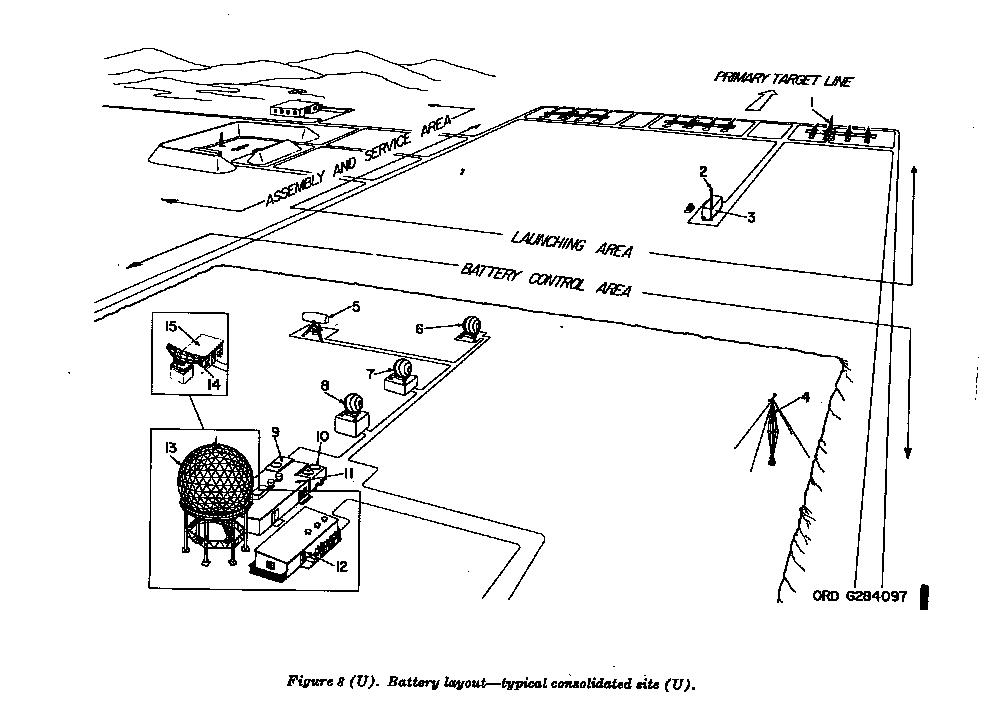 |
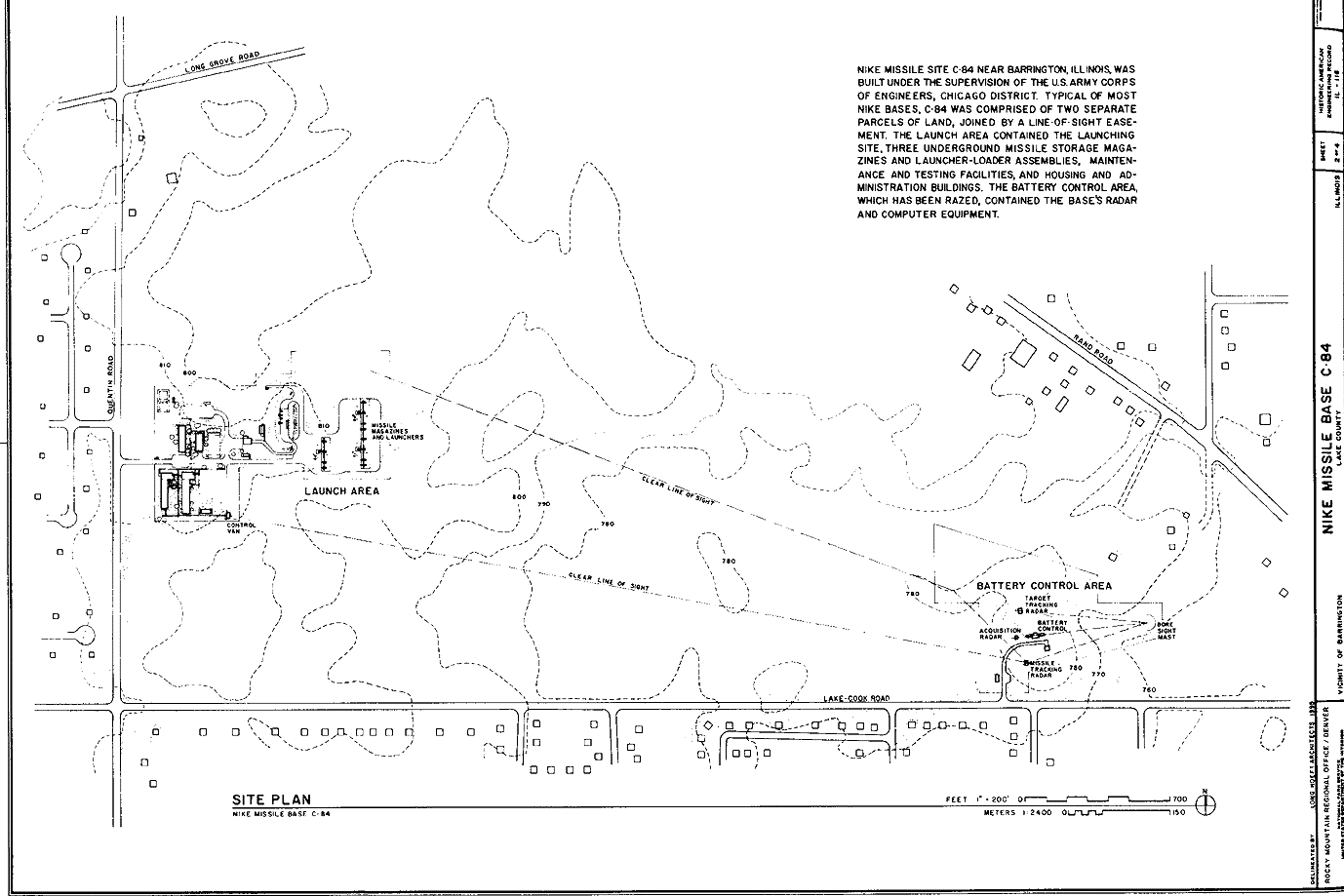 |
The battery control trailer officer contained the missile guidance computer, the acquisition radar scope and controls, and the telephone switchboard. From here the battery commander identified targets and directed missile launches. The radar control trailer held controls and electronic equipment A building able of hosting maintenance and spares trailer contained test equipment and spare parts and 12 Nike Ajax missiles, had an elevator that lifted the missile to the surface in a horizontal position. Three diesel generators were installed to provide electrical power to this area. In a building he contain also frequency converters, and missile assembly and maintenance structures The electric cabling system transmitted data within the control area and to the launch area. A collimation test mast was placed at each battery control area to provide a common reference point for adjusting the radars
But quickly Army to was constraint to construct underground magazines. Once above ground, the missile could be pushed manually along a railing to a launcher placed parallel to the elevator. Typically four launchers sat atop the magazine.
The Nike Hercules Missile
 |
Nike Ajax was a system of the early 1950s ans at the end of the 1950s the missile was incapable of stopping a massed Soviet air attack Nike Hercules was also designed to use the supporting components of the Nike Ajax system. To engage hostile targets, missilemen followed procedures similar to those used with the Nike Ajax.
Works for a successor were initiated well before the first Ajax missiles were deployed
with three major considerations the new missile First he will be best in speed, range and altitude capabilities and he could be defend against the new generation of soviet weapons and finally he will be armed e with a powerful atomic warhead to ensure destruction of the target aircraft and the destruction of disabling of any nuclear weapons it carried.
in July 1953 the service authorized development of a second generation surface-to-air missile, because it was impossible to equipping Ajax with a nuclear warhead Designated W31 the Hercules nuclear warhead was available in three different configuration
low 3-Kilotons
medium 20-Kilotons
high yield 30-Kilotons
for comparison Hiroshima bomb was approximately a15 Kilotons bomb
 |
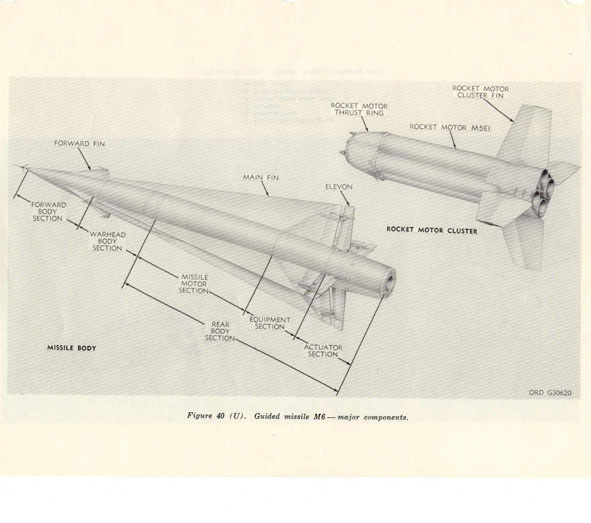 |
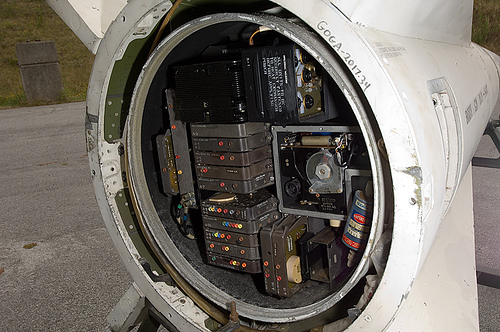 |
In early 1958, some of these missiles were initially equipped with an heavier, nuclear warhead designated W 7
Additional warhead designs, including "cluster" type warheads containing numerous sub munitions, were developed but they were not deployed operationally on the missile.
Western Electric was the primary contractor with Bell Telephone Laboratories providing the guidance systems and Douglas Aircraft serving as the major subcontractor for the airframe. Originally designated as Nike B, the Nike Hercules was a far more capable missile than its predecessor With a maximum range of about 150kms, maximum a maximum speeds of excess of mach 4 and the ability to reach targets at altitudes of up to 45 kms Nike Hercules was a highly potent air defense weapon
He received also a more sophisticated radar and guidance systems . During the early sixties, an "Improved" version of the Nike Hercules missile system, utilizing ABAR (Alternate Battery Acquisition Radar) or HIPAR (High Power Acquisition Radar) was deployed.
.But the Nike Hercules provides some innovation
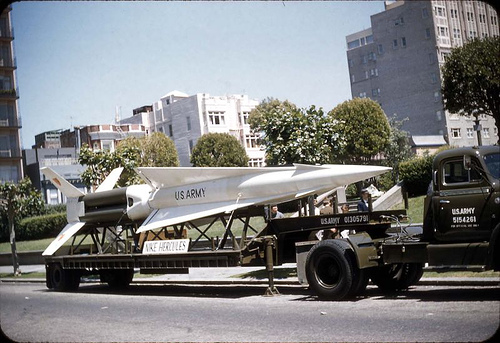 |
He could be mobile . This element increased the flexibility of this system, permitting the powerful capabilities of this versatile missile system to be extended wherever this could prove useful. Trucks and trailers were used to transport Nike Hercules system components to the desired field locations. In this mode, a single missile was mounted upon a truck-drawn trailer/launcher unit which also served as a firing platform
But now whe know that also the Nike Hercules could be alos used as a SS (surface-to-surface) missile against concentrations of enemy troops and armored vehicles, or other significant targets from bases and field deployments with a maximum range of 183 kilometers, and the limite of the effective transmission range of the Missile Tracking Radar (MTR )
This surface capability might also have proven useful in other areas where the Hercules missile was deployed including South Korea, Taiwan, and Turkey.
And he could be fire against ships or submarines from coastal sites in the continental United States also appears to have been considered.
The potential of the Improved Hercules was demonstrated on June 3rd. 1960, when a Nike Hercules missile scored a direct hit on a Corporal missile in the sky over White Sands.
Nike Zeus
 |
Nike Zeus, the final Nike missile, was aimed at intercontinental ballistic missiles (ICBMs), Zeus was the third missile in the Nike family, and brought Nike development into the ICBM era. Named for the ruler of the Greek Gods, the Zeus missile measured 19.30m , had a diameter of 153 cms, and weighed 1.8tons at launch. The tandem booster, designed by Thiokol, had a thrust of 205 tons the highest ever attained through a single nozzle. The Zeus had a range of more than 250 miles. The Nike Zeus system also included the Zeus Acquisition Radar (ZAR), a significant improvement over the Nike Hercules HIPAR system. Shaped like a pyramid, the ZAR featured a Luneberg lens receiver aerial weighing about 1,000 tons. The first successful intercept of an ICBM by Zeus was in 1962 at Kwajalein in the Marianas Islands
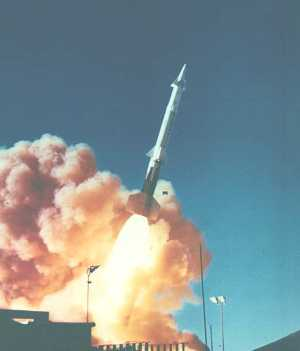 |
Dispite its technological advancements, the Department of Defense terminated Zeus development in 1963. The Zeus system, which cost an estimated $15 billion, suffered from several technical flaws, including an inability to distinguisd enemy warheads from chaff, reflectors, and other types of decoys. Still, the Army continued to develop an anti-ICBM weapon system -- referred to as "Nike-X" -- that was largely based on the technological advances of the Zeus system. Nike-X featured phase-array radars, computer advances, and a missile tolerant of skin temperatures three times those of the Zeus. In September 1967, the Department of Defense announced the deployment of the Sentinel antiballistic missile system, major elements drawn from Nike-X development.
 |
In March 1969, the Army deployed the Saffeguard program, which was designed to defend Minuteman missiles, and which also was based on the Nike-X system
Guidance and Control
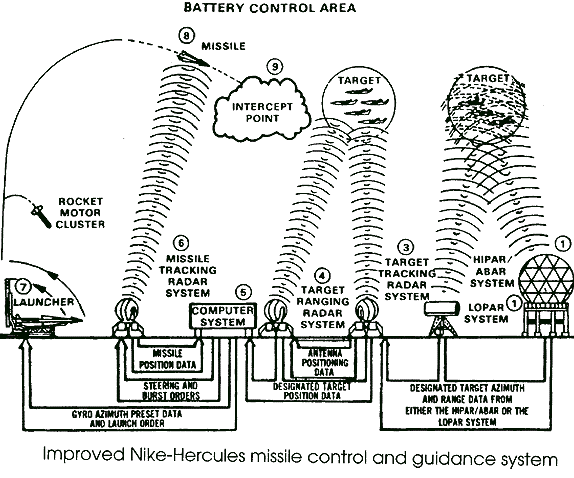 |
Nike was guided entirely from the ground, from firing to warhead detonation. The electronic "eyes" (radar) and "brain" (computer) of the Nike system were located on the ground, within the Intergrated Fire Control or IFC Area.
Target information would normally have been derived from regional Army air defense control centers. The regional control centers determined which aerial targets were to be fired on by individual Nike missile batteries. Having acquired and positively identified a hostile aircraft, a second radar, the Target Tracking Radar (TTR) would be aimed at and electronically locked onto it.
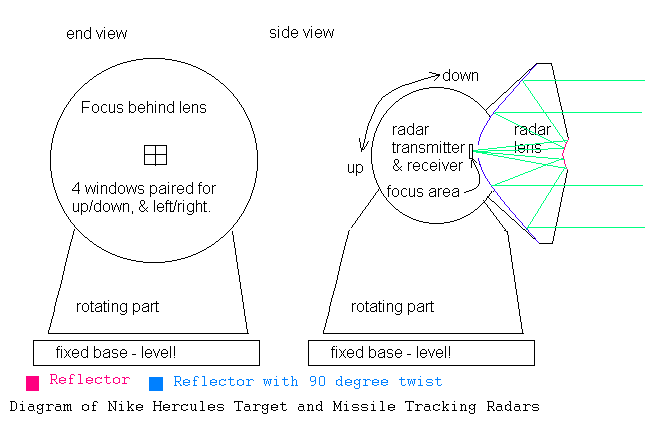 |
This radar would then follow the selected aircraft's every move in spite of any evasive action taken by its pilot. A third radar, the Missile Tracking Radar (MTR) was then aimed at and electronically locked onto an individual Nike missile located at the nearby Launcher Area.
.jpg) |
.jpg) |
Both the TTR and MTR were linked to a guidance computer located within the Battery Control Trailer at the IFC Area.
.gif) |
The analog computer continuously compared the relative positions of both the target aircraft and the missile during its flight and determined the best course the missile would have to fly in order to reach its intended target. Steering commands were computed and sent from the ground to the missile during its flight, via the Missile Tracking Radar. At the moment of closest approach the missile's warhead would be detonated by a computer generated "burst command" sent from the ground via the MTR.
.jpg) |
.jpg) |
Alternately the warhead could be exploded via contact fusing when it impacted the selected target or target area
A Nike Hercules Missile Site
Because of the larger size of the Nike Hercules, an underground magazine’s capacity was reduced to eight missiles.hus, storage racks, launcher rails, and elevators underwent modification to accept the larger missiles New sites, located away from populated areas did not have to be confined in acreage. Consequently, these batteries were all above ground
A typical Nike air defense site consisted
One area as Integrated Fire Control Area (IFC). This site contained the Nike system's ground-based radar and computer systems designed to detect and track hostile aircraft, and to guide the missiles to their targets.
One area as the Launcher Area.
.gif) |
At the launcher area, Nike missiles were stored horizontally within heavily constructed underground missile magazines.
A large, missile elevator brought the Nikes to the surface of the site where they would be pushed (manually) by crewmen, across twin steel rails to one of four satellite launchers. The missile was then attached to its launcher and erected to a near-vertical position for firing. The near-vertical firing position ensured that the missile's booster rocket (lower stage) would not crash directly back onto the missile site, but, instead, would land within a predetermined booster impact area. The 2 area were separated by a distance of 1,kms to 6 kms were often located within different townships.
.gif) |
Whenever possible, control areas were constructed on high ground in order to gain superior radar coverage of the area.
Nike Deployment
Since jun 30th 1958, Us Army deployed 145 Nike Hercules batteries. Of that number, 35 were built exclusively for the new missile and 110 were converted Nike Ajax installations. With the exception of batteries in Alaska and Florida that stayed active until 1978 all Nike Hercules sites had been deactivated from 1974
Like the Nike are upon the supervision of the Us Army we found a fight among
.jpg) |
USAF with is project BOMARC and US Army with the Nike The USAF claiming that the Nike Army missile duplicated the capabilities of this soon-to-be-deployed BOMARC.
Nike Hercules batteries were located in the New York, Philadelphia, and Chicago defense areas were they constituted defensive "rings" surrounding major urban and industrial area Additional Nike sites protected key Strategic Air Command bases and other sensitive installations, such as the nuclear facilities at Hanford, Washington.
Nike missiles were also deployed overseas with U.S. forces in Europe and Asia, by the armed forces of many NATO nations (Germany, France, Denmark, Italy, Belgium, Norway, the Netherlands, Greece and Turkey), and by U.S. allies in Asia (Japan, South Korea, and Taiwan).
End Of The Nike Era
With the devellopement of the ICBMs or Intercontinental Ballistic Missiles military strategy change
As a result, beginning in the mid 1960s, the total number of operational Nike bases within the continental U.S. was fairly steadily reduced, All Nike Ajax sites in USA were closed down by 1964. and in 1974, all remaining operational sites within the nationwide Nike air defense system were inactivated.
Army Air Defense Command (ARADCOM) was closed down shortly thereafter.
Nike missiles remained operational at a small number of sites in southern Florida and in Alaska for several more years and with U.S. forces in Europe and the Pacific, and with many U.S. Allies overseas.
.jpg) |
.gif) |
|
Now the Nike Hercules is retired Bases were dismantled or transformed in Museums or civilian habitations
 |
Cities and Sites Protected by Nike Installations
Abilene, Texas
• Albany Georgia
• Anchorage, Alaska
• Austin, Texas
• Baltimore, Maryland
• Barksdale AFB, Louisiana
• Boston, Massachusetts
• Buffalo - Niagara Falls, New York
• Chicago, lIlinois
• Cincinnati- Dayton, Ohio
• Cleveland, Ohio
• Dallas - Fort Worth, Texas
• Detroit, Michigan
• Ellsworth AFB, South Dakota
• Fairbanks (Fort Wainwright), Alaska
• Hanford Reservation (Department of Energy), Washington
• Hartford, Connecticut
• Kansas City, Missouri
LoringAFB, Maine
Key West, Florida
Los Angeles, California
Miami (Homestead AFB), Florida
Milwaukee, Wisconsin
Minneapolis-St. Paul, Minnesota
Mountain Home AFB, Idaho
New Haven, Connecticut
New York, New York
Norfolk, Virginia
Oahu, Hawaii
Omaha - Lincoln, Nebraska
Philadelphia, Pennsylvania
Pittsburgh, Pennsylvania
Providence, Rhode Island
Robins AFB, Georgia
San Francisco, California
St. Louis, Missouri
Seattle, Washington
Spokane, Washington
WalkerAFB, New Mexico
Washington, DC
Tecnical data
Length: 12.5m
Diameter:800mm
Wingspan: 1.90m
Weight: 4.8T
Booster fuel: Solid propellant
Missile fuel: Solid propellant
Range: Over 120kms
Speed: Mach 3.65
Altitude: Up to 45kms
Guidance: Command by electronic computer and radar
Warhead: High-Explosive fragmentation or nuclear